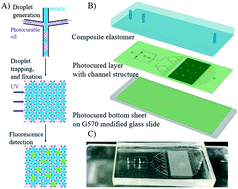A photofabricated honeycomb micropillar array for loss-free trapping of microfluidic droplets and application to digital PCR†
Abstract
Droplet microfluidics is a promising platform for various biological and biomedical applications. Among which, droplet-based digital PCR (ddPCR) is one of the most challenging examples, with practical issues involving possible fusion/fission of droplets during PCR thermocycling and difficulties of indexing them for real-time monitoring. While spatially trapped droplet arrays may be helpful, they currently are either of low trapping density or suffer from high droplet loss. In this paper, we, for the first time, report a photofabricated honeycomb micropillar array (PHMA) for high-density and loss-free droplet trapping. By rationally designing high-aspect-ratio micropillars into a honeycomb configuration, droplets can be captured at a density of 160–250 droplets per mm2 and, more interestingly, without any loss. The PHMA device can be fabricated from several photocurable materials, with one gasproof photopolymer being optimally selected herein to enable the simple design to avoid sample evaporation and tedious surface modification, thereby making the fabrication very convenient. Moreover, by using a photocurable oil as a continuous phase, the trapped droplets can be further immobilized, and thus, become more stable even in PCR thermocycling. With these features, the proposed PHMA has shown promising potential in ddPCR, and is expected to find a wide range of applications in various biological and biomedical research.



 Please wait while we load your content...
Please wait while we load your content...